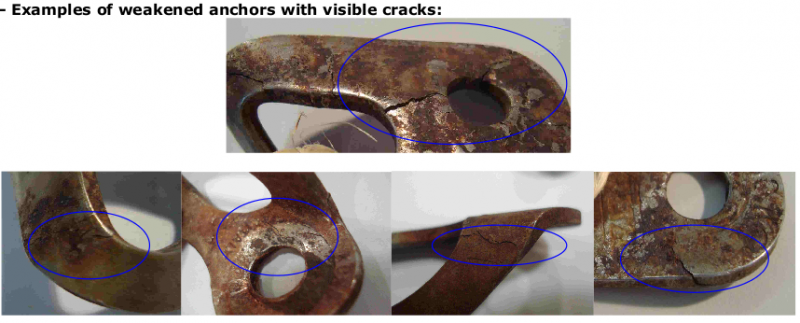Risks of anchor failure
Recent accidents alerted us to the probability of weakened anchors on routes equipped in tropical, marine environments.
These anchors have been weakened by corrosion accelerated by the proximity of the sea and year-long, warm, wet climates. First samplings from some climbing areas in tropical marine environments showed that 10 to 20% of anchors could have a resistance as low as 1 kN to 5 kN (cf. Nominal climbing falls load anchors with forces of 1 kN to 5 kN; a 25 kN minimum bolt strength is required by the standards)!!
All the anchors concerned are stainless steel in accordance with the standard requirement. The low strength may be caused by oxidation, galvanic corrosion, and/or stress-corrosion cracking - a complete analysis is in progress within the UIAA Safety Commission. These mechanisms are further enhanced when metals that are inappropriate for use in marine environments are installed on cliffs in coastal areas. The many mechanisms and materials involved make it impossible for a climber to determine the integrity of a bolt by inspection.
Our advice if you climb on routes equipped in tropical, marine environments: Before any climbing, we strongly recommend that you enquire with the local climbers and/or with the local people who equipped the routes about the quality of the anchors in place. Some areas are regularly re-equipped. If the equipment is less than 3 years old, experience to date suggests that the probability of finding a weakened anchor is low, even though bolt failure has been known to occur within 9 months of installation.
On the other hand, if you detect signs of rust on the anchors, this can indicate a badly weakened anchor. In that case, do not load the anchor, and retreat from the climb (experience from the field shows that some anchors would break when loaded with only the weight of the climber).
Alert the local climbers/local people who take care of the maintenance of the climbing area, so that they can check and replace the weakened anchor; you could also replace the weakened anchor yourself.

As a precautionary principle, we strongly advise you NOT to climb on routes in tropical, marine environments which show signs of rust on anchors and/or where you do not know either the person responsible for maintenance of the climbing area, or when the equipment was installed.
In the absence of reliable information about the integrity of anchors from the locals who maintain the bolts at a tropical, marine cliff, climbers must consider coastal, bolted routes as adventure terrain where all fixed anchors are questionable, as is the case in alpine climbing. Ultimately, it is the climber him/herself who is responsible for his/her decisions and actions regarding the integrity of the anchors.
Source: UIAA